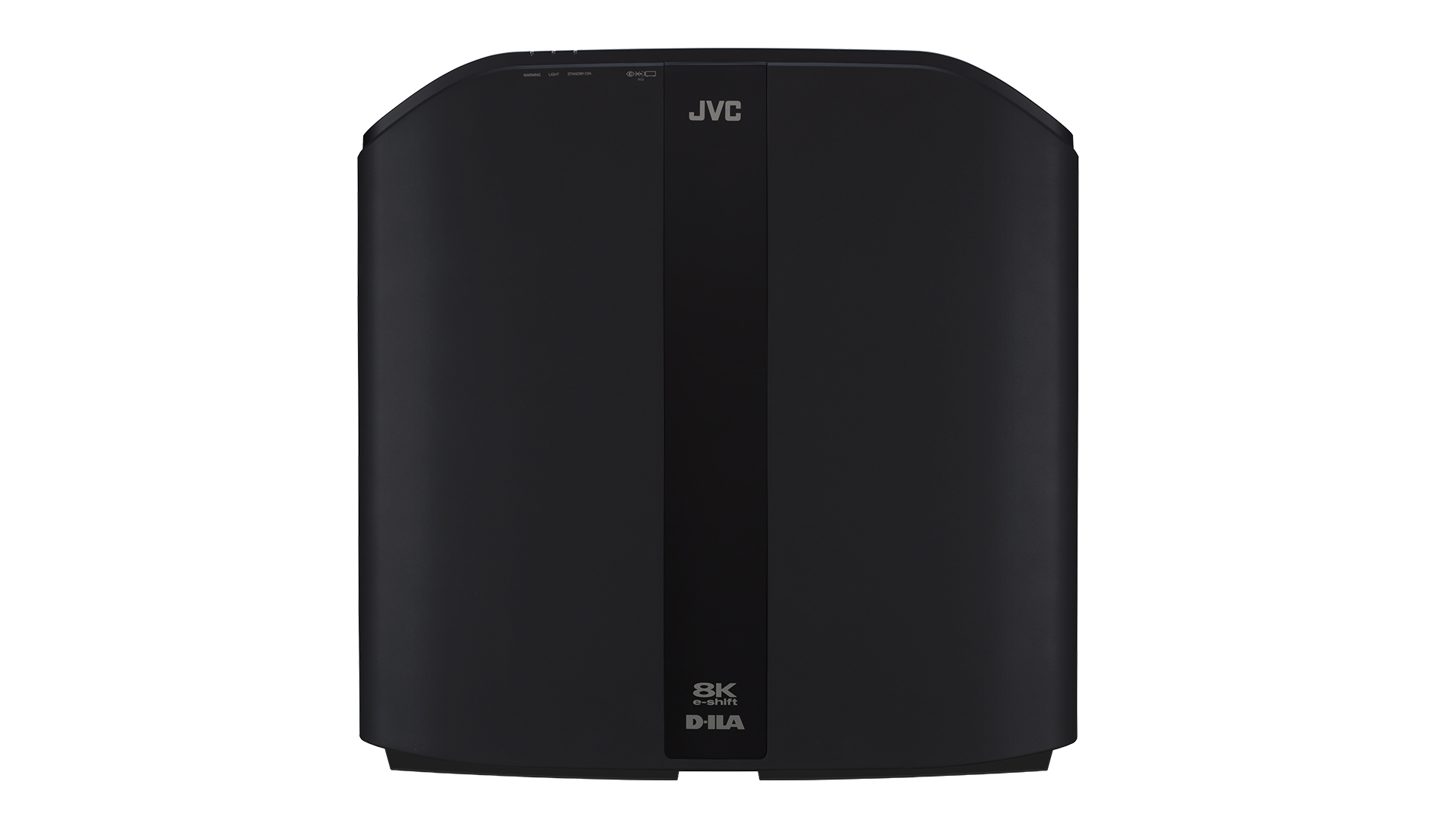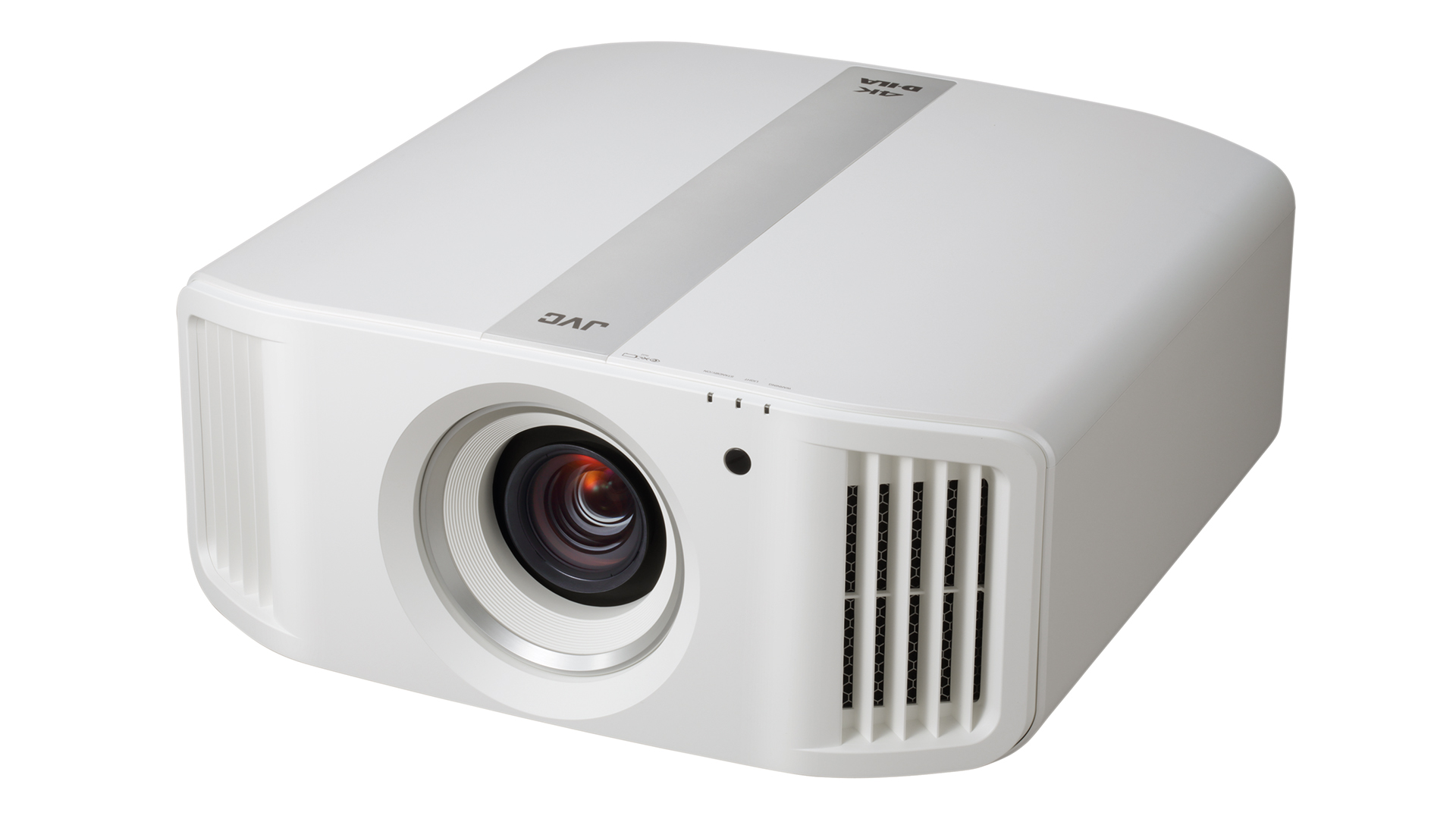What Hi-Fi? Verdict
If you can’t afford one of JVC’s new laser projectors, this lamp model is a mighty fine back up plan
Pros
- +
Outstanding contrast
- +
Excellent HDR playback
- +
4K/120Hz support
Cons
- -
Expensive for a lamp projector
- -
No VRR support
Why you can trust What Hi-Fi?
The DLA-NP5 is JVC’s most affordable D-ILA projector for 2022 – and with JVC’s cheapest laser D-ILA models setting you back well into five figures, we have a funny feeling that interest in the lamp-based NP5 could be seriously high. Especially now that the ‘Covid years’ have given us all a whole new appreciation of the value of a high-quality home entertainment system.
Price
By using a lamp rather than lasers, JVC is able to sell the NP5 for £7499 / $7000 / AU$10,995. This compares with £11,499 / $11,000 / AU$15,999 for the step-up, laser-toting DLA-NZ7.
That step-up model does also use JVC’s e-shifting technology to deliver a claimed 8K resolution versus the NP5’s native 4K, but nice though that extra pixel density might be to have on a really big screen if money’s no object, being able to save thousands of pounds or dollars by ‘making do’ with the NP5’s native 4K resolution will seem like a pretty decent compromise to many.
Sony’s upcoming XW5000, which will offer a native 4K resolution and laser projection for just £5999 / $6000 / AU$9995, looks set to give the NP5 some stiff competition. But if the NP5 can maintain the sort of contrast for which JVC’s D-ILA technology is legendary, it could well still feel worth the extra.
Design

The word that best describes the DLA-NP5 is ‘brute’. It really is a substantial thing; half a metre wide by nearly half a metre deep and perhaps most strikingly of all, a seriously chunky 23cm tall.
Its bulk establishes right away that despite its entry-level positioning, this is still very much a serious home cinema projector likely to find its way into a dedicated cinema room rather than a living room. It’s not unattractive for all its heftiness, though, thanks to its rounded corners, impressively heavy-duty finish and large, centrally mounted lens. It’s just not living-room levels of attractive.
The NP5 is the only model in JVC’s 2022 D-ILA range to be available in white or black colour options.
The latest hi-fi, home cinema and tech news, reviews, buying advice and deals, direct to your inbox.
Features

The DLA-NP5 is built around JVC’s D-ILA optical system. This JVC-exclusive variant of liquid crystal on silicon technology has been renowned for years now for its ability to deliver black levels that other projector technologies still can’t match today. We’re talking native black levels (and remarkable attendant contrast ratios) here, too – as in, the class-leading black levels and contrast are achieved without needing help from the sorts of brightness-adjusting dynamic iris systems other projector systems have to depend on.
There are no moving elements (such as DLP colour wheels) involved with D-ILA technology either, so you don’t have to worry about things such as rainbow-effect RGB striping, or fizzing noise.
Despite the NP5 being JVC’s new entry-level D-ILA projector, it still retains a native 4K resolution. Thankfully, there’s no slip back to JVC’s old ‘e-shift’ pseudo 4K technology.
The NP5’s lamp is powerful enough to deliver a claimed 1900 lumens of peak brightness – a decent amount for a lamp-based model that’s as (correctly) interested in contrast as it is brightness. That native contrast is in this case claimed to be an exceptional 40,000:1, which rises to an extraordinary 400,000:1 if you deploy the projector’s excellent dynamic contrast ratio feature.
The NP5 boasts a pretty high-quality lens arrangement for JVC’s entry-level D-ILA option. Its 17-element, 15-group, all-glass 65mm design should certainly help the projector deliver well on its native 4K pixel count.
The NP5’s HDR support is a cut above the projector norm, too. There’s the HDR10 handling that any HDR-capable device must provide, but also support for both the HLG format often used for live broadcasts (and required for UK satellite broadcaster Sky’s HDR system), and HDR10+: the ‘active’ form of HDR10 that adds extra scene by scene source picture information to the HDR stream to help compatible displays deliver more accurate results.
Also key to the NP5’s talents are its Frame Adapt HDR and Theater Optimizer features, which transformed JVC’s D-ILA HDR projection performance overnight when they were introduced last year. These essentially add up to a dynamic tone mapping system that can study every incoming HDR frame or scene and optimise it to the projector’s capabilities.
This includes improving gamma accuracy from 12 to 18 bits, and crucially transforms the brightness the NP5 can pump out (lack of brightness being arguably historically D-ILA projection’s only consistent weakness).

Dimensions (hwd) 234 x 500 x 495mm
Processing Clear Motion Drive, Frame Adapt HDR, Theater Optimizer
Screen size up to 200 inches
Native resolution 4096 x 2160
Input with 60Hz in game mode 36ms
Projector type D-ILA with lamp lighting
Another rare talent sported by the DLA-NP5 is support over both of its 48Gbps bandwidth HDMI 2.1 ports for the 4K graphics at 120Hz refresh rates now available from the PS5 and Xbox Series X games consoles, as well as the latest premium PC graphics cards. This rare 4K/120 support is backed up by a decently low 36ms input lag measurement when using the projector’s low latency mode. There’s no support for variable refresh rates, but the 4K/120Hz support really is a treat in itself by the standards of the current projector world.
The NP5’s other connections include an RS-232C control port, a LAN port, a 12v trigger port and a 3D sync port. The 3D sync port, of course, alerts you to the fact that while TVs may have long given up on 3D playback, it’s still alive and kicking in the projector world.
Setting the NP5 up is incredibly easy thanks to its provision of totally motorised (and so controllable via the remote control) zoom, focus and image shift adjustments.
Picture

Let’s get the extremely limited amount of bad news about the NP5’s picture performance out of the way first, starting with the simple fact that it doesn’t manage to get as bright for HDR playback as JVC’s laser models. If you want to put a number on this, JVC itself quotes 300 lumens more for the step-up laser-toting NZ7 than the 1900 lumens the NP5 can deliver.
The extra brightness also unlocks a slightly wider colour range performance on JVC’s laser models, while their 8K e-Shift technology gives a smoother finish with slightly more pristine-looking curved and diagonal lines.
Looked at more fairly on its own merits, though, rather than considered against its massively more expensive laser siblings, pretty much the only picture quality negative we can come up with is an occasional slightly patchy look to skin tones. Otherwise, it’s all good. Seriously good.
For starters, the NP5 lives up to D-ILA’s reputation for excellent contrast and black levels. Even the darkest parts of the darkest pictures are delivered with rich, deep, natural black colours far less troubled by greyness or inconsistency than they are on any other projector in its class. Or the vast majority of projectors in much higher classes, come to that.
The excellent black levels also help make dark scenes look every bit as convincing, detailed and full of depth and subtlety as bright scenes. Even when showing the most high-contrast HDR images.
Talking of contrast, the DLA-NP5’s outstanding delivery of dark picture content also helps it get impressive impact from its 1900 lumens of brightness – especially if you activate its Frame Adapt HDR and Theater Optimizer Dynamic Tone Mapping features, which add much more punch to the projector’s HDR presentation without seemingly doing any damage to proceedings.
The NP5’s tone mapping delivers its extra brightness, too, without usually leaving colours looking thinner. In fact, while just occasionally a really peak bright colour can look a touch more washed out than it does with the dynamic tone mapping features off, for the most part colours actually look more radiant and boldly saturated with tone mapping on, representing a much fuller sense of the wide colour gamuts associated with HDR pictures than JVC projectors did before the dynamic tone mapping software rolled into town. It’s actually pretty amazing to see how much of a difference to a lamp-based version of JVC’s established D-ILA projection technology new image processing can make. But we’re certainly not complaining.
Despite the extra richness and punch of the NP5’s colours, the projector’s processing is good enough to ensure that even the finest and subtlest colour blends are rendered without striping interference or any ‘flaring out’ of bright details. Even pure white elements of HDR pictures tend to keep all their shading.
Once you finally manage to stop ogling the NP5’s black levels and contrast, you start to lap up the sharpness and detail of its 4K pictures instead. There’s a superior sense of fine detail and a generally crisper look with native 4K sources than there was with JVC’s old ‘e-Shift’ pseudo 4K projectors.
The clarity holds up fantastically well during action scenes, too, thanks to impressively natural motion handling with 24p movie sources that retains a cinematic feel without adding any distracting ‘hardware judder’ to the presentation.
The default setting of JVC’s motion processing tends to leave the picture looking a little too smooth, but at least it doesn’t generate many distracting side effects. In any case, though, we don’t think many users will feel the need to leave the feature on.
The NP5’s sharpness is delivered, too, without any sense of over-sharpening or exaggeration of grain or other noise. The NP5 both upscales HD content to 4K beautifully and delivers standard dynamic range content with all the exceptional subtlety and purity we’ve now come to expect from JVC’s ultra-refined D-ILA engine.
Add to all this the absence of really any sort of picture noise together with a remarkably quiet lamp cooling system for such a bright projector, and you’ve got the most all-round immersive and cinematic projector we’ve seen before you get to five figures.
Verdict

Don’t be put off by the DLA-NP5’s lack of laser lighting. Yes, you will likely have to change a bulb or two during your time with it, but the rewards for this occasional bit of maintenance are consistently gorgeous all-round picture quality at a fraction of the price you’d need to pay for one of JVC’s laser models.
SCORES
- Picture 5
- Build 4
- Features 5
MORE:
Read our review of the Sony VPL-VW590ES
Also consider the JVC DLA-N5
Read our review of the LG HU810PW
Best projectors 2022: Full HD, 4K, portable and short-throw
What Hi-Fi?, founded in 1976, is the world's leading independent guide to buying and owning hi-fi and home entertainment products. Our comprehensive tests help you buy the very best for your money, with our advice sections giving you step-by-step information on how to get even more from your music and movies. Everything is tested by our dedicated team of in-house reviewers in our custom-built test rooms in London, Reading and Bath. Our coveted five-star rating and Awards are recognised all over the world as the ultimate seal of approval, so you can buy with absolute confidence.

